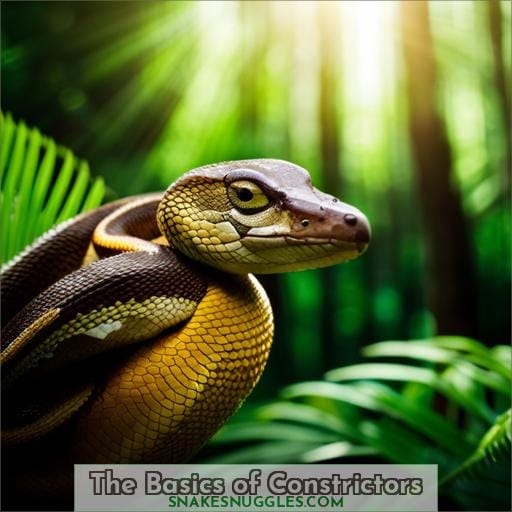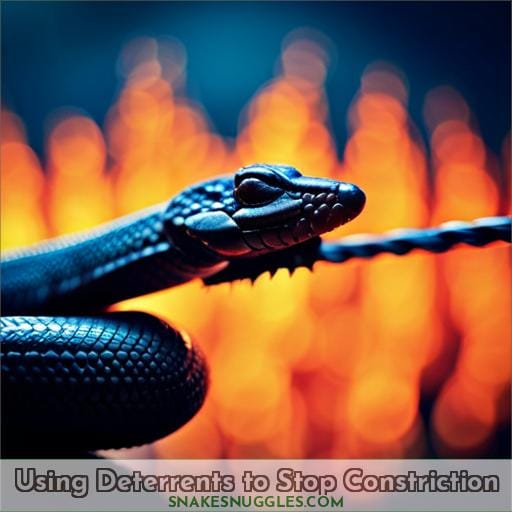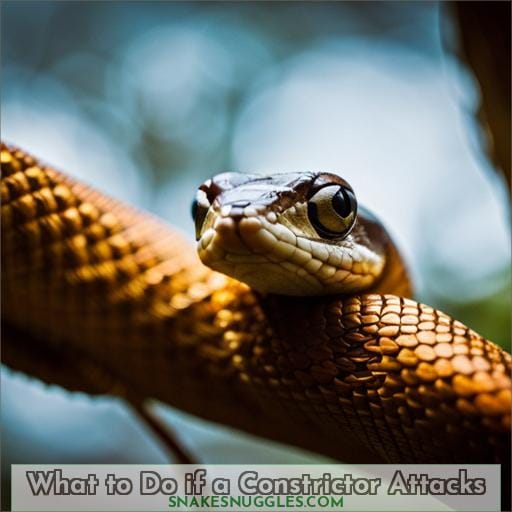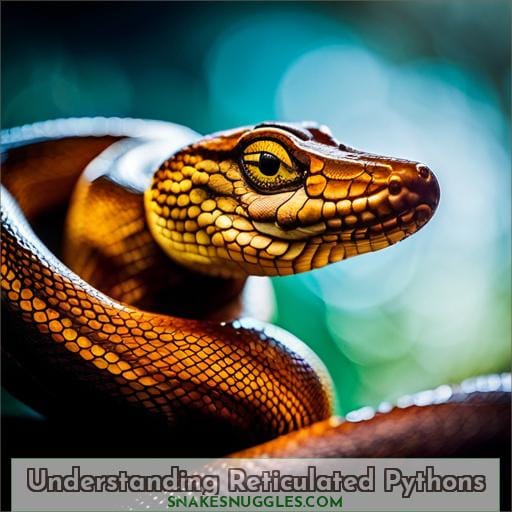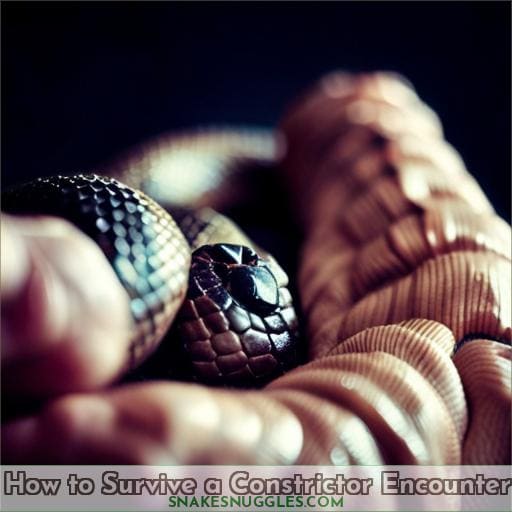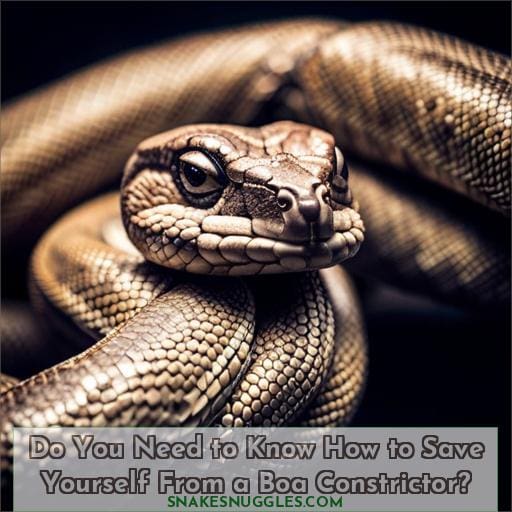This site is supported by our readers. We may earn a commission, at no cost to you, if you purchase through links.
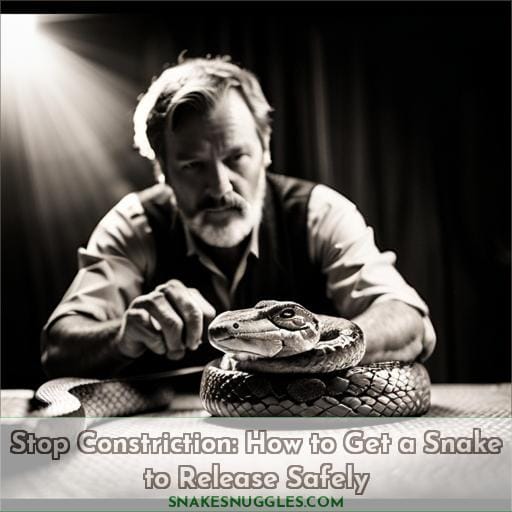 Holding a snake can be like dancing with danger – if they feel threatened, constrictors may try to wrap themselves around you. Constriction is how non-venomous snakes kill their prey in the wild, but they could also constrict on humans when handled incorrectly.
Holding a snake can be like dancing with danger – if they feel threatened, constrictors may try to wrap themselves around you. Constriction is how non-venomous snakes kill their prey in the wild, but they could also constrict on humans when handled incorrectly.
Knowing how to get them to stop and release safely is an important part of understanding these creatures and coexisting peacefully with them.
In this article, we’ll look at the basics of constricting snakes and explore different methods for stopping a snake from wrapping itself around you or your pet. We’ll discuss deterrents such as spraying the snake or breaking its jaw in order to make it let go quickly and safely.
We’ll also cover what to do if a reticulated python attacks and the precautions that need to be taken when living near one. Understanding more about boas can help keep us safe, so we’ll delve into that as well.
Lastly, we’ll provide safety tips for dealing with any type of constricting situation.
Table Of Contents
- Key Takeaways
- The Basics of Constrictors
- How to Unwrap a Constrictor
- Using Deterrents to Stop Constriction
- What to Do if a Constrictor Attacks
- Understanding Reticulated Pythons
- Coexisting With Constrictors
- How to Survive a Constrictor Encounter
- Do You Need to Know How to Save Yourself From a Boa Constrictor?
- Frequently Asked Questions (FAQs)
- Conclusion
Key Takeaways
- React instinctively, squeezing prey until the heart stops. Unwind gently from tail to head to release.
- Tickling the snake’s sides or spraying unpleasant tastes like vinegar can make them let go.
- Use gloves, hooks if restraining is necessary. Avoid distressing the snake.
- Stay calm if attacked. Unwind, tickle, spray alcohol. Wait for release.
The Basics of Constrictors
You can use instinctual tactics, deterrents, and unwinding techniques to help constrictors release their grip. Non-venomous snakes are natural constrictors that react instinctively when presented with prey.
When a snake wraps around its target, it begins squeezing until the heart of the victim stops beating.
To get them to let go, you must use reactive methods as they respond differently than other animals or reptiles do in similar situations. Tickle the sides of a snake while unwinding from tail to head; this is especially effective when dealing with aquatic snakes since they have scales more sensitive on their bellies than those located on top or sides of body parts.
Spraying vinegar or alcohol into an attacking snake’s mouth may also be used as deterrents due to their unpleasant taste and smell. However, make sure never to break off any part of your pet’s tail if possible because doing so could cause injury and lead to further complications down the line, such as infection within the wound created by breaking bone apart.
Finally, always remember that patience is key whenever encountering an uncooperative serpent that has taken hold onto something using its vice-like grip. Just take a deep breath, remain calm, and slowly but surely start working your way up from the end tip towards the head region in order to remove coils without causing any harm to both you and the animal involved.
How to Unwrap a Constrictor
When dealing with a constrictor snake, it is important to unwind the tail from the head calmly and gently. To do so, you should grasp the tail end firmly but delicately as you move your hands in opposite directions along the snake’s body until all coils are removed.
By doing this safely and carefully, you can help ensure that both yourself and your pet remain safe during handling.
Unwinding the Tail to Head
Gently grasp the snake’s tail and slowly unwind it from head to toe, taking care not to yank or pull too hard. Unwinding techniques, such as tickling the sides of a constrictor, can be used to irritate and persuade it into releasing its grip.
Deterrent sprays like vinegar or alcohol in its mouth can create an unpleasant taste for it that will cause them to let go. Breaking a snake’s jaw should only be done when absolutely necessary on large, dangerous snakes.
Corn snakes are usually too small and harmless towards humans. Knowing how python survival skills work is key. They sense heartbeats through pressure, which triggers their constricting reflex.
Calmly and Gently Unwinding
Unwind the snake’s coils slowly and calmly, carefully guiding its tail towards the head. As you do so, pay attention to any changes in pressure or tension—this is a sign of wild instincts kicking in.
If it starts to tighten again, try spraying vinegar or alcohol near its mouth for an unpleasant taste sensation that will hopefully encourage release. You may also want to dunk its head underwater if this doesn’t work; however, be aware that some boas can grow quite large and become man-eaters! Be sure not to break the tail as they are too small and fragile compared with larger constrictors like pythons.
When handling snakes, always follow safety tips such as keeping pets away from areas where snakes might hide when outdoors – use sticks and blades if needed – plus keep kids close by while walking outside at night in python territory! With care on both sides, humans can coexist peacefully alongside pet constrictors – just remember these vital safety precautions every time you handle them!
Using Deterrents to Stop Constriction
When it comes to preventing constriction from a pet snake, there are several measures you can take. Spraying the snake with vinegar or alcohol will create an unpleasant taste, while breaking its jaw is only necessary in extreme cases.
With careful handling and deterrents such as these, snakes can be kept safe while still retaining their wild instincts.
Spraying the Snake
Spraying a deterrent such as vinegar or alcohol on the constrictor’s head can be like pouring cold water over the snake, helping it to loosen its coils.
There are several ways of deterring an attack from a constricting pet snake:
- Vinegar spraying stimulates an unpleasant taste in the mouth and can cause the snake to release.
- Dunking their head underwater helps them realize that they need to breathe and encourages them to let go.
- Breaking their tail should only be done for large, dangerous snakes because smaller ones such as corn snakes won’t hurt humans even if they attempt it.
- Keeping rat populations down prevents diseases, which is beneficial for human coexistence with pythons who have lived peacefully alongside us for thousands of years in some cases.
- Carrying sharp sticks or blades may cut away at coils if necessary, but it’s not advised unless absolutely necessary since python attacks are rare when proper safety precautions are taken.
It is important that people take all necessary precautions when dealing with any type of pet snake so everyone stays safe while allowing these creatures to live out their natural lives without being disturbed by unnecessary human interference.
Breaking Its Jaw
Breaking a snake’s jaw should only be used as a last resort, if all other methods of deterring the constriction have failed.
Snakes are instinctual and retain their wild instincts, meaning they will constrict when they sense danger or movement. To get them to release from this behavior, it’s best to unwind its tail gently from head-to-tail in most cases.
Additionally, spraying vinegar or alcohol on its head can create an unpleasant taste that may cause it to let go as well.
Breaking the snake’s jaw should not be done unless absolutely necessary due diligence has been taken in avoiding attack with both humans and animals alike. Understanding how island boas differ in size, learning about undergrad participation research studies conducted concerning reticulated pythons, and knowing how one might coexist harmoniously with snakes overall by keeping rat populations down so disease doesn’t spread amongst them are all key aspects of living safely around these creatures once better understood through education.
What to Do if a Constrictor Attacks
If you find yourself in the unfortunate situation of being attacked by a constrictor snake, there are preventive measures that can be taken to increase your chances of survival. Waiting for the constriction reflex to subside is one option; however, having a partner or tools such as sticks and blades on hand will also help defend against potential danger.
Waiting for the Constriction to Stop
Tickle the sides of the constrictor to irritate it and persuade its release. If this fails, you can try spraying a mild vinegar or alcohol solution into its mouth for an unpleasant taste that will hopefully get it to let go.
In some cases, submerging the head underwater may also cause them to loosen their grip on their prey as they need oxygen just like us.
Different species have different eating habits and size differences which result from genetic factors as well as environmental changes such as climate impacts influencing hibernation behavior or availability of food sources in certain areas.
It’s important for humans interacting with these animals in any capacity to be aware of these nuances so they don’t end up putting themselves at risk unnecessarily due to lack of knowledge or ignorance about how best to handle them safely and effectively if needed without causing harm either way!
Having a Partner and Tools for Defense
Having a partner and tools for defense can help you protect yourself if a constrictor snake attacks, so don’t go it alone. First, have an ally to unwind the coils. Second, bring deterrent tastes like alcohol or vinegar that have proven effective at making snakes release their grip on prey.
Lastly, arm yourself with sticks or blades to cut off the coils in case of ambush tactics by larger pythons.
Wild instincts will cause them to attack quickly and without warning; however, understanding heartbeats triggers helps reduce the risk of harm when coexisting with these creatures in nature.
Understanding Reticulated Pythons
Reticulated pythons are large snakes that can reach up to 30 feet in length and have been known to attack humans. As such, it is important for individuals living or traveling in python areas to take certain precautions; understanding that reticulated pythons can grow over 32 feet long and weigh over 350 pounds, making them a potential danger, as explained in more detail about what is a reticulated python; understanding the size of a reticulated python and its potential danger will help ensure safety.
Size and Danger
Be aware that reticulated pythons, while smaller than mainland boas of the same species due to limited food supplies, can still pose a danger if not respected. Protecting pets and other animals is paramount when encountering these snakes in their natural habitat or captivity.
Diet affects size as well as hibernation cycles, making captive breeding an important consideration for those considering this breed of snake as a pet.
Natural habitats are typically tropical areas such as Indonesia and Malaysia, which means temperatures must be kept warm for the optimal health of any pet python owned by humans coexisting peacefully together.
Precautions to Take in Python Areas
Take caution when around pythons – venturing too close could lead to a surprise constriction! Recognize danger signs, like raised heads and flared hoods. Be alert for ambush spots such as tall grass or logs. Have defensive tools handy – stick, blade, alcohol spray – in case of an attack.
If you do find yourself trapped by coils of muscle power, don’t panic. Remain still and slowly unwind the tail towards its head instead. If trapping snakes is necessary, use gloves and long-handled hooks to prevent bites while trying not to distress them too much.
Above all else, be aware of your surroundings at all times. Remaining vigilant can help avert trouble before it starts, so there’s no need for confrontation if proper precautions are taken!
Coexisting With Constrictors
Controlling rat populations and living with constrictors safely are essential to human coexistence. Understanding the behavior of constricting snakes is key; they instinctively use their coils to stop their prey’s heartbeats by cutting off blood flow, and should only be unwound from tail to head gently yet insistently.
Controlling Rat Populations
You can help control rat populations by coexisting with constrictors in a safe and responsible way.
- Practice proper snake safety when handling pet snakes.
- Take precautions when walking in areas where reticulated pythons may be present.
- Utilize pest control methods that involve human behavior, such as trapping, rather than using chemicals or poisons which can damage the environment.
- Support conservation efforts that protect these creatures from extinction.
Careful consideration of all these factors will lead to healthier ecosystems for both humans and animals alike – allowing us to better understand their roles within our shared spaces. Taking a proactive approach towards understanding how we interact with wildlife is key for creating harmonious living conditions between species.
Living With Constrictors Safely
By understanding the instinctual behavior of constrictors and taking precautions, you can coexist with them safely. Unwind snakes from tail to head gently but insistently, and use deterrents like vinegar or alcohol for an unpleasant taste.
Be wary of reticulated pythons, which can reach 30 feet in length and have been known to attack humans.
Island boas are generally smaller than their mainland counterparts due to limited food supplies.
If attacked, splash the snake’s head with alcohol as it will deter them away from attacking further.
With care, we can all live harmoniously together. Human coexistence helps keep rat populations down, thus aiding in disease prevention too!
How to Survive a Constrictor Encounter
Staying calm and avoiding confrontation are key to surviving a constrictor encounter. Research and experience have taught us that these methods are effective in persuading a snake to release its grip. It is essential to understand the behavior of constrictors so that you can remain safe when faced with this situation.
Knowing how best to react, even during times of distress, will ensure your safety in such an encounter.
Staying Calm and Avoiding Confrontation
Stay calm and avoid confrontation when dealing with a constrictor, as attempting to wrestle it away can be like playing tug-of-war with an anaconda.
- Unwind the tail gently, from head to end.
- Tickle its sides instead of grabbing or poking at it.
- Spray vinegar or alcohol in its mouth for unpleasant tastes that will make them release more quickly.
- Dunking the snake’s head underwater may also help get them to let go and breathe again properly.
Captive care guidelines must be followed carefully; they have specific needs based on species size differences and fear response times which must not be ignored if humans are going to coexist peacefully alongside these creatures long term!
Learning From Research and Experience
Gleaning from research and experience, you can develop an understanding of how constrictor snakes react to different stimuli.
Heartbeat
Movement
Biting Triggers Constriction
Spraying Alcohol Deters Attack
Instincts Retain Wild Behaviour
Undergrad participation in experiments has revealed that boas sense heartbeats through pressure for their constriction reflexes.
Island boa size differences have been linked to limited food supply and genetics; thus, the same species could be smaller than mainland ones.
Python risks are real, with some reaching up to 30 feet – they kill by stopping blood flow rather than suffocation, so it is important to take precautions when walking in python areas or near them, such as carrying a stick or blade for defense if attacked.
With care, human coexistence with pythons can still be possible while keeping rat populations down and preventing disease transmission at the same time, as they have lived together for thousands of years before, even though most today are not big enough anymore to eat people whole!
Do You Need to Know How to Save Yourself From a Boa Constrictor?
Being aware of the potential risks posed by boa constrictors may help you protect yourself and others in their presence. Boas can grow up to 30 feet long, so it’s important to take preventative measures when they’re around.
Food supply has a direct effect on their size. Island populations tend to be smaller due to limited resources. When selecting prey, aquatic habitats provide an easier target than terrestrial ones, as snakes are excellent swimmers and hunters underwater.
Human interaction should also be avoided if possible, since humans are too large for most pet snakes. But with special care, coexistence is achievable! Taking steps such as knowing your snake’s habits and diet preferences, and using deterrent tastes like vinegar or alcohol, can go a long way towards helping everyone stay safe.
- Learn behaviors specific to your species
- Understand how environment affects growth
- Choose food carefully based on habitat needs
- Take precautions when interacting with humans
Frequently Asked Questions (FAQs)
How often should I handle my pet constrictor?
Handle your pet constrictor regularly – but not too frequently! Excessive handling can cause stress, so limit it and enjoy bonding with them in a safe environment.
Are constrictors aggressive pets?
Constrictors can be aggressive, but they are not generally considered dangerous. With proper handling and care, they will retain their wild instincts without posing a threat to humans.
Is it safe to keep a constrictor in a home with children?
With care, constrictors can be kept safely in a home with children. Ensure food sources are limited to reduce size and aggression, splash alcohol on the head if threatened during handling, and supervise kids when outdoors to prevent ambushes.
What is the difference between a mainland and island boa?
Boas from mainland environments are usually larger than their island counterparts due to differences in food supply, genetics, and environment.
Are there any special requirements for keeping a reticulated python?
Reticulated pythons can be dangerous, reaching up to 30 ft. Take precautions when in python areas; keep children and pets away from potential ambush spots. Carry a stick or blade for greater safety, and splash alcohol on the head if needed.
Conclusion
With an estimated population of 150 million worldwide, snakes are one of the most common animals. However, many of us don’t know how to handle a constrictor snake if one were to attack. Knowing how to unwind a snake, use deterrents, and survive a constrictor encounter can save you from serious injury or even death.
To stop constriction, unwind the tail to the head, stay calm, and use deterrents such as alcohol or vinegar to make the snake release. When attacked, wait for the constriction to stop, carry a stick or blade to cut the coils, and splash alcohol on the head to deter the snake.
Reticulated pythons pose a serious risk, so take precautions such as not walking blindly where they hide and keeping children and pets away from python areas. With careful handling and an understanding of how to stop constriction, humans and snakes can coexist peacefully.
Knowing how to get a snake to stop constricting can help you stay safe in a variety of situations.

